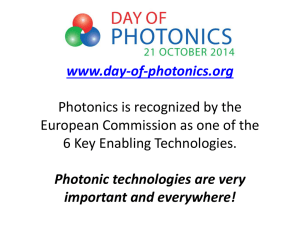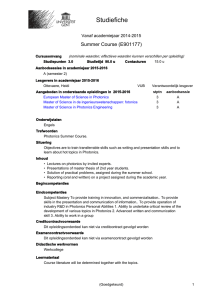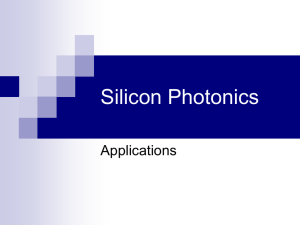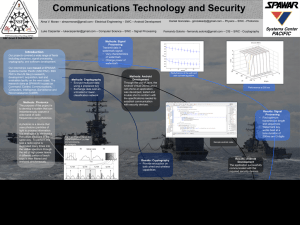Establishment of Photonics and Environmental Optics Laboratory
advertisement
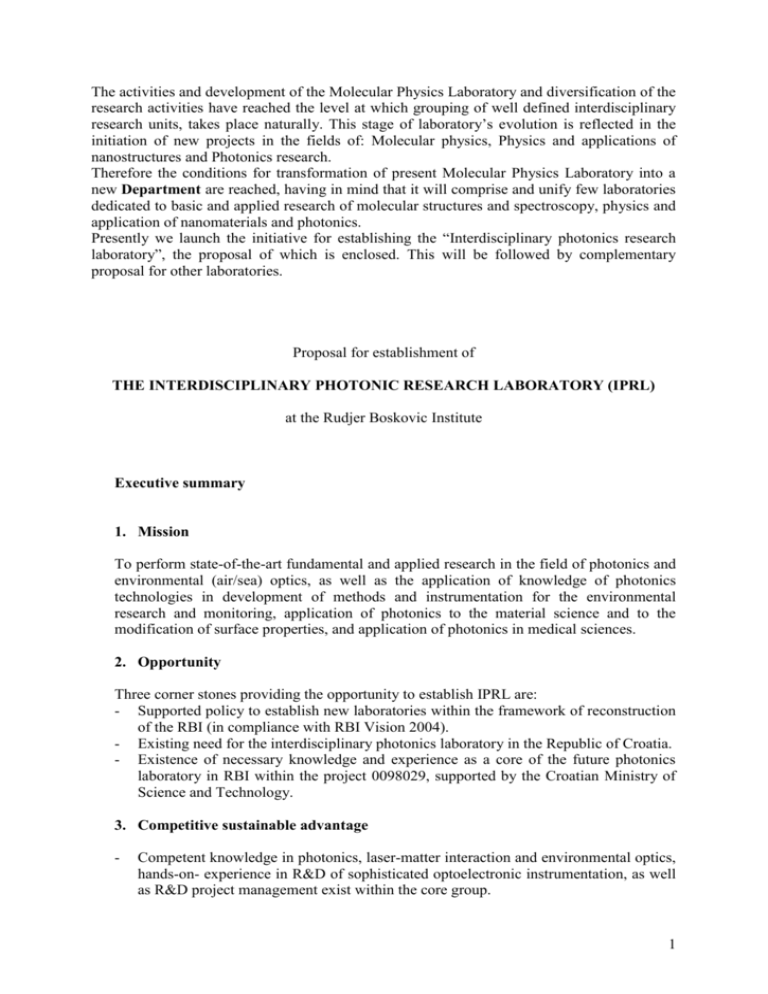
The activities and development of the Molecular Physics Laboratory and diversification of the research activities have reached the level at which grouping of well defined interdisciplinary research units, takes place naturally. This stage of laboratory’s evolution is reflected in the initiation of new projects in the fields of: Molecular physics, Physics and applications of nanostructures and Photonics research. Therefore the conditions for transformation of present Molecular Physics Laboratory into a new Department are reached, having in mind that it will comprise and unify few laboratories dedicated to basic and applied research of molecular structures and spectroscopy, physics and application of nanomaterials and photonics. Presently we launch the initiative for establishing the “Interdisciplinary photonics research laboratory”, the proposal of which is enclosed. This will be followed by complementary proposal for other laboratories. Proposal for establishment of THE INTERDISCIPLINARY PHOTONIC RESEARCH LABORATORY (IPRL) at the Rudjer Boskovic Institute Executive summary 1. Mission To perform state-of-the-art fundamental and applied research in the field of photonics and environmental (air/sea) optics, as well as the application of knowledge of photonics technologies in development of methods and instrumentation for the environmental research and monitoring, application of photonics to the material science and to the modification of surface properties, and application of photonics in medical sciences. 2. Opportunity Three corner stones providing the opportunity to establish IPRL are: - Supported policy to establish new laboratories within the framework of reconstruction of the RBI (in compliance with RBI Vision 2004). - Existing need for the interdisciplinary photonics laboratory in the Republic of Croatia. - Existence of necessary knowledge and experience as a core of the future photonics laboratory in RBI within the project 0098029, supported by the Croatian Ministry of Science and Technology. 3. Competitive sustainable advantage - Competent knowledge in photonics, laser-matter interaction and environmental optics, hands-on- experience in R&D of sophisticated optoelectronic instrumentation, as well as R&D project management exist within the core group. 1 - Good scientific environment, working premises and infrastructure exist within RBI Established links and scientific/technical cooperation with relevant partners (organizations and institutions) and potential customers already exist. 4. Present status of photonics R&D in the Republic of Croatia - - - Globally, photonics represent one of major R&D fields, and photonics market is one of the fastest growing. Interdisciplinary approach appears to be crucial for the future progress in environmental, medical and material sciences, in which photonics plays the key role. Presently, there exist no similar laboratories in the Republic of Croatia. The photonics and optical research in the Republic of Croatia, in comparison to that in EU are at low point, due to inefficient support and negligence. There is a need for proposed laboratory to complement the existing environmental research and monitoring conducted in Croatia by various institutions (including divisions of RBI), and supported by international or EU projects. There is also a need to implement photonics technology in a much broader and advanced level than dominating at present in the field of materials research and medicine. Interest to establish the proposed laboratory could be expected from The Ministry of Defense, The Ministry of Environmental Protection and Ministry of Health (the Croatian Institution for Radiation Protection). 5. Policies and Strategies: Research - Establishment and maintenance of excellence in research - Expansion and diversification of research areas through international cooperation and acquirement of externally financed projects/contracts, and joint ventures. Quality - Establishment and maintenance of high quality of research and operation standards (in compliance with HRN EN 17025) as well as application of good laboratory praxis in the research work. Staff - Starting with the core group, the increase of staff through novice training (Ms and Ph.D. degrees) and selection of candidates. Equipment acquirement and purchase - The purchase of new equipment limited to (preferably) multipurpose equipment - The purchase of second- hand equipment when appropriate - Temporary borrow of specific project/cooperation related equipment Financial - Starting with financing from the Ministry of Science and Technology, gradual increase of financing from external sources (international and domestic). Cooperation with University -Active involvement in the educational process at undergraduate and graduate studies. 2 -Introduction of photonics studies at the University of Zagreb on the level comparable to that in other EU countries. 6. The operating plan 5.1 Scope and objectives The Interdisciplinary photonics research laboratory conducts basic research directed toward potential applications of optics and photonics, and applied research, in the fields of environmental, material and medical sciences including special segments of military photonics applications. o o o o Objectives: Photonics in the environmental sciences Studies and monitoring of seawater and atmosphere by using the existing, and newly developed photonics and optical methods. Characterization and quantification of relevant processes (radiative transfer, material transport, aggregation, biological production etc.) and their dynamics. Determination of inherent and apparent optical properties of seawater, and detection, quantification, and characterization of dispersed/dissolved material. Development of new research methods and instrumentation. Photonics in the material sciences Absorptive laser-matter interactions will be used to modify surface properties of metals, alloys and plastics, as well as of layered and multilayered systems. Nonlinear and nonequilibrium process on solid surfaces that result in the formation of self-organized structures (SO) will be studied. Analysis of surface pattern formation, phenomena and SO structures; detection of their topological complexity and underlying dynamics, determination of parameters of the surface shear layer, will enable physical description of processes present in the pulsed LMI on short time scale but understanding of their technological role, as well. Photonics interactions of picosecond and femtosecond pulses with matter, and the study of ultrafast phenomena. Photonics in the medical sciences Use of photonics technologies for diagnostics and treatment in dentistry and medicine. Study of laser-tissue interaction. 5.2 Methods Photonics in the environmental sciences Theoretical methods include, but are not limited to the application of classical and advanced scattering theories (Mie, T-matrix etc), radiative transfer theory, Monte Carlo simulations and advanced optical design. Experimental methods include measurement of inherent and apparent optical properties (coefficients of absorption, scattering and backscattering, volume 3 scattering functions) fluorescence spectra, PSD and dissolved and dispersed material concentration. Photonics in the material sciences Experimental methods are based on the use of ns- laser pulses from: Qswitched Nd: YAG laser, N2 laser XeCl excimer laser and Q-switched ruby laser. Analyses of surface will be based on the optical and SEM microscopy (eventually TEM) numerical filtration of the micrographs, microhardness measurements, and Raman spectroscopy, when appropriate. Method of theoretical description of SO structures will be based on topological approach, dynamics of their formation on the hydrodynamic models adequate for description of coherent turbulent structures like: vortex filaments, braids of vortex filaments, vortex rings, cellular structures etc. 5.3 Cooperation 5.31. Internal The cooperation with other departments of RBI in particular Center for Marine and Environmental Research shall continue and expand. 5.3.2. Domestic The cooperation with other relevant institutions on mutual projects shall continue and expand (e.g. The Naval Institute, Ministry of DefenseInstitute of defense studies and R&D, etc.) 5.3.3. International Recently established contacts with foreign institutions and laboratories shall be expanded to the level of cooperation on joint projects. Participation in the ongoing EU programs of the ocean and environmental research is anticipated. 7. Organization/structure 7.1. Staff Starting with the core group of three researchers, the increase of laboratory staff through the novice training (MS and Ph.D. degrees) and selection of candidates: - two novices in the first year - two novices in the second/third year Further increase according to the declared policies and strategies 7.2. Premises Premises comprise the staff workrooms and dedicated laboratory space. In the first stage of laboratory development the staff workrooms are those already used by the core staff in wings VI and I (project 0098029) The laboratory space shall be expanded from the initial premises situated in the basement rooms of the I-wing and through careful redistribution of existing but not adequately used space available on RBI 7.3. Equipment The basic equipment comprises, but is not limited to: frequency doubled pulsed Qswitched Nd:YAG laser and tunable (Ti:saphire) laser, fiber optic spectroscopic UV- 4 VIS-NIR system (Ocean Optics), adequate power and energy meters and detectors, AC-9, and HydroScat -6 scattering/transmission meters. . Some of this equipment is scheduled to be bought through the existing project, some could be acquired through possible cooperation and the rest should be bought. Acquisition of femtosecond laser, fast detection system and optical table is also planned. 8. Financing Establishment of the laboratory and purchase of basic equipment is to be funded by RBI within framework of restructuring and establishment of new labs. Basic financing of the laboratory operation in the first stage is from the Ministry of Science and Technology (MST). Further purchases of equipment are to be financed partially from contracts/projects with the third parties and partially from the (MST) according to the declared policy and strategies. Estimated costs needed to furnish the main equipment for the proposed laboratory: Frequency doubled and quadrupled Nd:YAG LAB-130-10 laser: $60,000.00 Inherent optical properties measurement suite (attenuation and absorption at nine wavelengths + spectral backscattering meter) $55,000.00 ECO-BB2-Spectral backscattering meter and chlorophyll fluorometer $ 7,000.00 a-beta optical backscattering and absorption meter (6 wavelengths) $ 9,000.00 Opolette tunable laser system (410nm-2.4m) Type I $40,000.00 Fiber optic spectrometer/fluorometer UV-VIS-NIR $ 4,000.00 Laser power meter/energy meter $ 6,000.00 Storage oscilloscope $10,000.00 Optical and optoelectronic components $10,000.00 Supporting software $ 4,000.00 Vibration isolation tabletop systems $10,000.00 Diode pumped YAG laser (200W) $80,000.00 Total: $295,000.00 9. Dynamics Starting with year 2003 the proposed interdisciplinary photonics laboratory is expected to be established in the interval of 3-5 years. Purchase of the equipment and deployment will follow the financial support. The staff buildup shall start with two scientific novices for period 2003-2005 10. Effects Establishment of basic and applied research of photonics, thus fulfilling the existing scientific and technological gap in the republic of Croatia. Opening of new directions of research and development, as well as providing the support for industrial, environmental, medical and other fields. Modernization of educational program in photonics 5 Establishment of new, presently nonexistent connections between the Rudjer Bošković Institute, universities, industry and government bodies in relevant fields of activity. Establishment of internationally recognizable research subjects and scientific connections with other countries. Zagreb, November 15, 2002. Voditelj LMF Dr. sc. Krešimir Furić Dr. sc. Stjepan Lugomer 6
